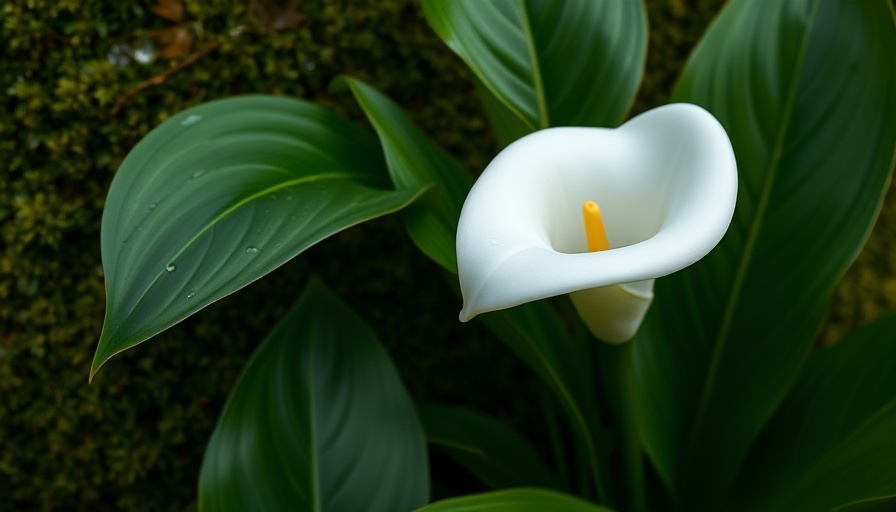
Understanding Calla Lilies: A Beautiful Addition to Your Garden
Calla lilies (Zantedeschia) are often mistaken for true lilies, but these elegant flowers belong to the arum family, bringing a touch of sophistication to any garden. Their stunning, funnel-shaped blooms are available in a variety of colors, providing endless possibilities for creative garden design. While they're well-suited for year-round growing in USDA Hardiness Zones 8 to 11, many gardeners across temperate climates choose to cultivate them as annuals. However, even the most devoted calla lily lovers can encounter challenges—most notably, drooping stems. Understanding the causes of this issue can keep your garden flourishing.
The Seven Common Causes of Drooping in Calla Lilies
Drooping stems can indicate a variety of issues affecting the health of your calla lilies. Here are the top reasons why you might notice your once-sturdy blooms bending:
- Bacterial Soft Rot: This rot, caused by the soilborne bacteria Erwinia carotovora, compromises the roots of your plants. The once-vibrant stems may exhibit yellowing and deformities. To mitigate this, be cautious with nitrogen-rich fertilizers and boost calcium levels in the soil, which promotes stronger growth.
- Excess Moisture: While callas enjoy moist soil, too much can lead to limp stems. Poor drainage or overwatering might be at fault. Regular checks of the rhizomes can help identify if your plants need relocating for better drainage or sunlight.
- Nitrogen Overload: While nitrogen is essential for growth, excessive amounts can lead to unhealthy plants that cannot support their own blooms. Striking the right balance is crucial for maintaining healthy calla lilies.
- Phototropism: Calla lilies naturally lean towards light, which may cause drooping if they aren’t receiving enough sunlight. Ensure they are getting a minimum of six hours of sunlight daily to encourage upright growth.
- Powdery Mildew: This fungal disease can weaken your plants and lead to limp stems. Regular monitoring and proper spacing can help mitigate the onset of mildew in your flowering endeavors.
- Top-Heavy Blooms: The large and often heavy blooms of the calla lily can lead to drooping stems if the plant’s structure cannot properly support them. Consider staking the stems if you’re experiencing significant drooping.
- Underwatering: Although an excess of moisture is detrimental, too little can also cause drooping. Striking the perfect watering balance is key to maintaining vibrant calla lilies.
Actionable Tips to Address Drooping
Addressing drooping stems in calla lilies requires a multi-faceted approach, focusing on plant care and proper gardening techniques:
- Regularly check soil moisture levels. Ideal moisture should be present, but avoid waterlogged conditions.
- Monitor your fertilization. Don’t rely solely on nitrogen; ensure an adequate supply of other nutrients like phosphorus and calcium.
- Ensure adequate light. Create a robust plan to position your calla lilies in the optimal sunlight.
Enhancing Calla Lily Growth through Proper Care
Understanding the needs of your calla lilies can also help prevent issues like drooping in the future. Here are additional best practices for maintaining a beautiful calla lily garden:
- Amendment of Soil: Regularly mix organic matter into the soil to improve drainage and nutrient content. Adding compost can significantly benefit overall plant health.
- Pruning and Maintenance: Periodically prune your flowers to encourage new growth and reduce the risk of diseases.
- Container Gardening: If planting in raised beds or containers, ensure they have sufficient drainage holes for optimal water flow.
Conclusion
With the right understanding of how to care for calla lilies and identify drooping causes, you can ensure that these elegant plants remain a stunning feature of your garden. By refining your gardening techniques, you not only enhance the health of your garden plants but also cultivate a rewarding hobby that promotes mental well-being. Enjoy the beauty and serenity that a flourishing flower garden brings to your life!
 Add Row
Add Row  Add
Add 




Write A Comment